TB NOTES

TB Notes 4, 2021
Notes from the Director

Dear Colleague,
Reflecting on 2021, I’m inspired by the continued commitment to eliminating tuberculosis (TB) our partners and TB program staff have demonstrated through yet another challenging year. The end of the year marks a time to reflect on achievements, and an opportunity to look forward to future goals. This final issue of TB Notes for 2021 offers a summary of some of the highlights and accomplishments from Division of Tuberculosis Elimination (DTBE) this year.
DTBE continues to support CDC’s response to COVID-19 and other responses. As of December 3, 2021, 123 DTBE staff members (77% of DTBE staff) have participated in 315 deployments. Thank you to all who have responded to the COVID-19 pandemic, as well as those of you who continued the important work in TB control and prevention.
DTBE continues to collaborate with our colleagues in the Division of Global Migration and Quarantine and other partners in support of Operations Allies Welcome. TB education materials are now available in Dari and Pashto, the two primary languages spoken in Afghanistan. These resources may be helpful as part of TB screening and follow-up of arrivals from Afghanistan.
- Questions & Answers About Tuberculosis booklet (Dari pdf icon[PDF – 11MB] and Pashto pdf icon[PDF – 11MB])
- Tuberculosis: General Information fact sheet (Dari pdf icon[PDF – 1MB] and Pashto pdf icon[PDF – 1MB])
The TB Centers of Excellence have also developed provider and patient education materials, including:
- Cultural Quick Reference Guide for Afghanistanexternal icon from Southeastern National Tuberculosis Center
- “You Can Prevent TB: TB-LTBI Patient Education Handout” from Southeastern National Tuberculosis Center (Dariexternal icon and Pashtoexternal icon)
- Flipbook: “What You Need to Know About Tuberculosis” from Heartland National TB Center (Dari and Pashtoexternal icon)
Additionally, the Advisory Council for the Elimination of Tuberculosis (ACET) virtual meeting will be held from December 14-15, 2021.
I look forward to working together in 2022 to continue our mission to eliminate TB. Thank you for your continued commitment and all that you have done this year.
Best wishes for a happy and healthy new year!
Philip LoBue, MD, FACP, FCCP
Director
Division of Tuberculosis Elimination
National Center for HIV, Viral Hepatitis, STD, and TB Prevention
This year, DTBE would like to reflect on the research, innovation, resources, and world events that shaped another momentous year. Here is a look back at some TB highlights for 2021.
Electronic Directly Observed Therapy (eDOT) presentation at 25th Annual Conference of the Union – North America Region
The COVID-19 pandemic spurred TB programs to initiate or expand digital health and telemedicine services. In February 2021, on behalf of the research team, Joseph Burzynski, MD, MPH (Assistant Commissioner at the New York City Department of Health and Mental Hygiene Bureau of Tuberculosis Control) presented the results of the eDOT Study – A randomized clinical trial of traditional, in-person directly observed therapy (DOT) versus electronic DOT for tuberculosis treatment at the Nursing Sponsored Session at the 25th Annual Conference of the Union – North America Region focused on Digital Health, Telemedicine, and Tuberculosis.
World TB Day

On March 24, DTBE recognized World TB Day, an annual event to commemorate the date in 1882 when Dr. Robert Koch announced his discovery of Mycobacterium tuberculosis, the bacillus that causes tuberculosis (TB). The 2021 World TB Day theme was “The Clock is Ticking.” This year was an especially unique year as CDC and partners commemorated this day with virtual activities due to the ongoing COVID-19 pandemic.
- CDC developed a World TB Day digital toolkit with graphics and videosexternal icon to help spread the “End TB” message.
- Partners who hosted a virtual event around World TB Day 2021, were featured on the World TB Day News and Events timeline. For the CDC U.S. TB Elimination Champions Project this year, CDC recognized organizations and individuals in the TB prevention and control community who made important contributions to the COVID-19 response and/or showcased the innovation and adaption needed to maintain TB elimination activities in a challenging public health environment.
- Additional activities included a Dear Colleague Letter from CDC Director, Rochelle Walensky, MD, MPH, highlighting the importance of timely diagnoses of TB disease and encouraging programs to regain the momentum lost due to the COVID-19 pandemic to end TB in the United States, new TB Personal Stories videos of five TB survivors and family of survivors bravely sharing their experiences battling latent TB infection and TB disease, social media messages, and more.
Tuberculosis Trials Consortium 2021-2030 cycle
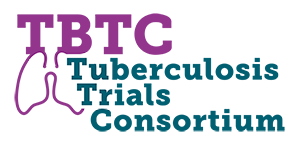
On March 31, DTBE announced the Tuberculosis Trials Consortium (TBTC) for the 2021-2030 cycle. CDC awarded contracts for the next ten-year research cycle, initiating the 28th year of the TBTC collaborative effort. The new and continuing members of TBTC combine outstanding scientific expertise and superb TB trials capacity. This exciting collaboration will continue to contribute to development of stronger approaches to the prevention and treatment of TB over the next decade. A Dear Colleague Letter provided more information about the new contract, including the awardees.
APHL Online Training Modules
In April 2021, the DTBE Laboratory Branch announced the release of updated online interactive training modules for the Association of Public Health Laboratories (APHL) “Essentials for the Mycobacteriology Laboratory: Promoting Quality Practices” training curriculum. Content for each of the thirteen modules was developed collaboratively with input from CDC and APHL members and has now been updated with knowledge check questions added for most modules. Previously, modules were housed on the APHL website. With the addition of an APHL Learning Management System, modules will now reside within the management system allowing continuing education credits to be received and course certificates to be printed. To access the APHL Mycobacteriology Laboratory Training Curriculum, visit https://www.aphl.org/training/Pages/Training-Portal.aspxexternal icon.
TBTC Study 31/A5349
On May 6, 2021, The New England Journal of Medicine published “Four-Month Rifapentine Regimens with or without Moxifloxacin for Tuberculosisexternal icon,” which highlights findings from Study 31/A5349, a collaboration of CDC’s Tuberculosis Trials Consortium (TBTC) and the National Institute of Health’s Adult AIDS Clinical Trials Group (ACTG). Study 31/A5349 is the first clinical trial to identify a shorter 4-month daily treatment regimen for drug-susceptible TB disease that is as effective as (non-inferior to) the existing 6-month daily regimen in curing TB disease. This is the first new treatment regimen for drug-susceptible TB disease in almost 40 years.
TB Disease and Bone Allograft Material Response
Beginning in late May, CDC, along with partners at state and local health departments and the U.S. Food and Drug Administration (FDA) responded to a TB outbreak associated with bone allograft used during surgery in several states. CDC, state and local health departments, TB Centers of Excellence, and healthcare providers continue to collaborate and provide expert clinical consultation for patients being treated for TB disease.
TB National Center for HIV/AIDS, Viral Hepatitis, STD, and TB Prevention Epidemiologic and Economic Modeling Agreement (NEEMA) Meeting
In July 2021, the NEEMA 2.0 cooperative agreement recipients, Albany/Coalition for Applied Modeling for Prevention (CAMP)/Johns Hopkins University (JHU) and Stanford/Prevention Policy Modeling Lab (PPML), presented their work in collaboration with DTBE staff from Year Two. Sourya Shrestha (JHU) presented analyses of large (≥10 clustered cases) U.S. TB outbreaks from 2012-2016. Sun Kim (PPML) presented work on trends, mechanisms, and racial/ethnic differences in TB incidence in the U.S.-born population aged ≥ 50 years. Nicole Swartwood (PPML) presented an expansion of the Tabby2 webtool that estimates (by U.S.-state) the numbers and costs of people tested and treated for latent TB infection and the impact of user-selected interventions on TB cases averted, TB deaths averted, quality adjusted life-years saved, and cost-effectiveness. Topics and plans for Year Three of the cooperative agreement were discussed among all meeting participants.
Tuberculosis Epidemiological Studies Consortium III
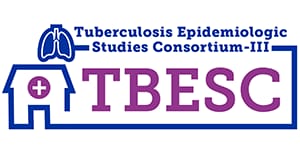
The launch of the Tuberculosis (TB) Epidemiologic Studies Consortium (TBESC) III for the 2021–2026 cycle was announced at the end of September 2021. TBESC-III will lead to a better understanding of how TB infection screening, testing, and treatment is offered to patients in primary care settings, as well as the effectiveness and efficiency of potential public health interventions to increase the number of eligible patients who complete latent TB infection treatment.
Reported Tuberculosis in the United States, 2020
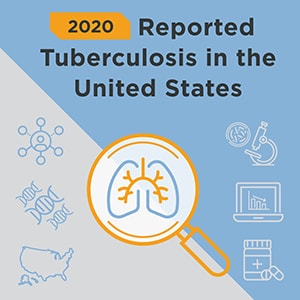
On October 25, 2021, DTBE published Reported Tuberculosis in the United States, 2020 online. The report describes information on TB disease reported to the CDC since 1993, with an emphasis on TB disease cases counted by the reporting area in 2020, and the effects of the COVID-19 pandemic on TB disease surveillance. TB data from 2020 data reveal a substantial decline in the number of reported cases of TB disease in the United States. The COVID-19 pandemic has probably affected reported TB incidence in the United States in several ways, including a combination of TB underdiagnosis and a true reduction in incidence. CDC is conducting additional analyses to better understand how the 2020 TB data compare with previous years.
COVID-19 Response
Throughout the year, DTBE staff members continued to respond to the COVID-19 pandemic as did many TB program staff. DTBE’s embedded field-based staff have also participated in the response efforts of their assigned local jurisdictions.
Additional updates from the Division of TB Elimination:
Updated “TB 101 for Health Care Workers” Online Course Now Available
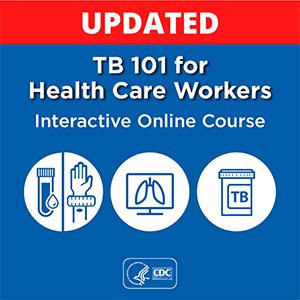
CDC recently released an updated version of the TB 101 for Health Care Workers online course. This interactive online course includes six lessons that are designed to educate participants about basic concepts related to TB prevention and control in the United States:
- Lesson 1: Introduction
- Lesson 2: TB Transmission and the Development of TB Disease
- Lesson 3: Testing for TB Infection
- Lesson 4: Diagnosis of TB Disease
- Lesson 5: Treatment of Latent TB Infection
- Lesson 6: Treatment of TB Disease
The target audience for the course includes newly hired TB program staff and health care workers in areas related to TB. It is also a great resource for any health care worker to refresh their knowledge of TB.
Originally released in 2012, the TB 101 online course continues to be an important part of education for TB program staff and TB health care workers. Over 10,000 learners have received CE credit after completing the course!
The 2021 version has been updated with the latest guidance on the treatment of latent TB infection and TB disease. The course contains interactive features such as videos, knowledge checks, and case studies to reinforce key concepts. The revised online course now has the post-test built into the course, so that after completing the course and passing the post-test, participants can generate a certificate of completion for their records. The course is also now available in responsive design for use on tablets as well as desktops.
The updated course was pilot tested by 20 public health professionals, including registered nurses, laboratorians, and certified health educators. Below are a few select comments from course participants:
- “I enjoyed this course. It was easy to understand and to the point.”
- “Thank you for providing this very useful course, it has been instrumental in improving my knowledge on TB and providing clear public health guidance to partners.”
- “I enjoyed the course! Well done!”
TB 101 for Health Care Workers meets CDC’s Quality Training Standards, as verified through CDC’s continuing education accreditation process. In addition, continuing education (CE) credits for this course are available free of charge for CNE, CEU, CECH, and CPH.
Submitted by Beth Bouwkamp, MPH, BA, ORISE Fellow
Hep B United / TB Elimination Alliance Summit
From November 2-4, 2021, Hep B Unitedexternal icon and the TB Elimination Allianceexternal icon hosted the first joint summit: “Centering Community to Advance Health Equityexternal icon.” The virtual summit focused on outreach to Asian American, Native Hawaiian, and Pacific Islander communities who are disproportionately affected by hepatitis B and TB. Speakers included clinicians, representatives from community-based organizations, and survivors who described their lived experiences with hepatitis B and TB. All resources from the summit are now available on the TB Elimination Alliance website at https://tbeliminationalliance.org/external icon.
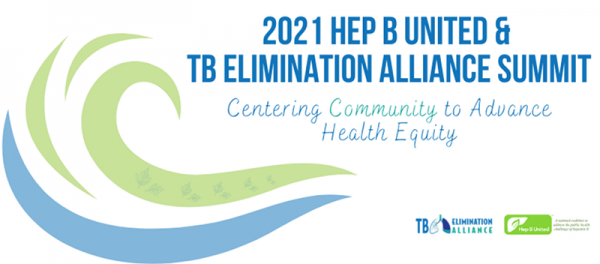
The TB Elimination Alliance will also be hosting “A Conversation with CDC Partners” with Dr. Carolyn Wester, Director of the Division of Viral Hepatitis (DVH), and Dr. Philip LoBue, Director of the Division of Tuberculosis Elimination (DTBE), on Thursday, January 20 at 1-2pm PT/4-5pm ET. Register here: https://bit.ly/AConversationwithCDCPartnersexternal icon.
Tabby2 Can be Used to Estimate State-level Future TB, and Costs Associated with Targeted LTBI Testing and Treatment
Tabby2 is an interactive webtool to estimate future U.S. TB cases. It can help states develop or revise their TB elimination plans. The Harvard TH Chan Prevention Policy Modeling Lab developed the tool based on a published TB transmission model,1 with funding by the NCHHSTP Epidemiologic and Economic Modeling Agreement (NEEMA). Tabby2external icon provides state-level projections of TB and latent TB infection based on state-specific historical trends, in addition to national projections based on national trends. Currently, 25 U.S. states are modelled, with the remaining 25 states and the District of Columbia to be completed soon. Tabby2 allows users to choose pre-defined or to specify custom intervention scenarios to compare with baseline projections through 2050. The new tool includes functionality to estimate the number and cost of latent TB infection tests, latent TB infection treatment, and TB disease cases, as well as the cost-effectiveness of hypothetical interventions. These resource-specific projections allow users to set informed targets to make a compelling case to further TB elimination in their states.
Submitted by Suzanne Marks, MPH, MA, DTBE, Nicole A. Swartwood, MSPH, Harvard TH Chan Prevention Policy Modeling Lab (PPML), Nick Menzies, PhD, PPML, and Andrew Hill, PhD, DTBE
1Menzies NA, Cohen T, Hill AN, Yaesoubi R, Galer K, Wolf E, Marks SM, Salomon JA. Prospects for Tuberculosis Elimination in the United States: Results of a Transmission Dynamic Model. American Journal of Epidemiology. 2018. https://www.ncbi.nlm.nih.gov/pubmed/29762657external icon
Analysis of TB cases from National Tuberculosis Surveillance System (NTSS)
Indigenous persons have the highest annual TB case rates of any racial or ethnic group in the United States, according to an analysis of 11 years of TB cases from the National Tuberculosis Surveillance System (NTSS).
The analysis, conducted by a team from DTBE’s Surveillance, Epidemiology, and Outbreak Investigations Branch (SEOIB), found that annual TB incidence rates among American Indian or Alaska Native (AI/AN) and Native Hawaiian or other Pacific Islander (NHPI) populations were on average at least 10 times higher than among the U.S.-born non-Hispanic White population. The study included 36,509 TB cases in U.S.-born persons counted within the 50 states and the District of Columbia during 2009-2019. The analysis, conducted by Yuri Springer, Steve Kammerer, Benjamin Silk, and Adam Langer, was recently published in the Journal of Racial and Ethnic Health Disparitiesexternal icon.
“Given the persistence of TB disease as a significant, endemic public health problem facing U.S. indigenous persons, intensified, culturally-sensitive efforts are needed to reduce disparities by strengthening TB prevention and control measures focused on AI/AN and NHPI communities,” the authors said.
The authors compared annual crude and age-adjusted TB incidence rates for AI/AN and NHPI and non-Hispanic Whites. Although they jointly represented only 4% of the TB cases reported during the period, either the AI/AN or the NHPI group had the highest crude and age-adjusted annual TB case rates among U.S.-born persons in every year of the investigation period.
For the AI/AN group, crude annual TB case rates ranged from 7.5 per 100,000 persons (2010) to 3.7 cases per 100,000 (2019). Compared to the White population, crude annual incidence rate ratios (IRR) ranged from 6.5 (2009) to 13.5 (2015); the IRR for 2019 was 9.3. Age-adjusted IRR ranged from 8.3 (2009) to 16.1 (2015).
For the NHPI population, crude annual TB case rates ranged from 1.2 per 100,000 persons (2013) to 8.4 per 100,000 (2017). Compared to the White population, crude annual IRR ranged from 2.1 (2013) to 20.1 (2017); the IRR for 2019 was 11.8. Age-adjusted IRR ranged from 3.0 (2013) to 21.7 (2018).
At the time of diagnosis, both AI/AN and NHPI persons with TB were more likely than White persons with TB to have been diagnosed with end-stage renal disease (ESRD) or chronic renal failure, or with diabetes, although both groups were less likely to be HIV positive compared to White persons with TB. ESRD is associated with higher risk for TB-related mortality, and diabetes with more severe TB symptoms, delayed sputum conversion, and increased risk of TB treatment failure, recurrent disease, and death during TB treatment. In addition, AI/AN persons with TB ≥15 years old were more likely than White persons with TB to report excess alcohol and non-injection drug use, and to have experienced homelessness or unemployment during the 12 months prior to TB diagnosis. These four sociobehavioral characteristics have been linked to increased rates of TB exposure and infection, more severe and prolonged TB symptoms, and higher probabilities of treatment failure and death.
The authors noted that these disparities are “particularly disheartening” given the central roles that U.S. indigenous populations have played in epidemiologic studies to assess BCG vaccines and isoniazid for prevention and treatment of TB. The authors recommended that TB control programs for these populations combine traditional TB control measures with concurrent interventions to detect and treat clinical comorbidities, promote behavioral health, and stabilize and improve employment and housing conditions.
Submitted by Yuri Springer, PhD; Steve Kammerer, BS, MBA; Benjamin Silk, PhD; and Adam Langer, BS, DVM, MPH
Reses HE, Fajans M, Lee SH, Heilig CM, Chu VT, Thornburg NJ, Christensen K, Bhattacharyya S, Fry A, Hall AJ, Tate JE, Kirking HL, Nabity SA; U.S. COVID-19 Household Investigation Team. Performance of existing and novel surveillance case definitions for COVID-19 in household contacts of PCR-confirmed COVID-19external icon. BMC Public Health 2021;21(1):1747.
Sahni LC, Avadhanula V, Ortiz CS, Feliz KE, John RE, Brown CA, Lively JY, Rha B, Munoz FM, Piedra PA, Dunn JJ, Boom JA. Comparison of mid-turbinate and nasopharyngeal specimens for molecular detection of SARS-CoV-2 among symptomatic outpatients at a pediatric drive-through testing siteexternal icon. J Pediatric Infect Dis Soc 2021;10(8):872–9.
Wortham JM, Meador SA, Hadler JL, Yousey-Hindes K, See I, Whitaker M, O’Halloran A, Milucky J, Chai SJ, Reingold A, Alden NB, Kawasaki B, Anderson EJ, Openo KP, Weigel A, Monroe ML, Ryan PA, Kim S, Reeg L, Lynfield R, McMahon M, Sosin DM, Eisenberg N, Rowe A, Barney G, Bennett NM, Bushey S, Billing LM, Shiltz J, Sutton M, West N, Talbot HK, Schaffner W, McCaffrey K, Spencer M, Kambhampati AK, Anglin O, Piasecki AM, Holstein R, Hall AJ, Fry AM, Garg S, Kim L. Census tract socioeconomic indicators and COVID-19–associated hospitalization rates—COVID-NET surveillance areas in 14 states, March 1–April 30, 2020external icon. PLoS One;16(9):e0257622.
Sandhu P, Shah AB, Ahmad FB, Kerr J, Demeke HB, Graeden E, Marks SM, Clark H, Bombard JM, Bolduc M, Hatfield-Timajchy K, Tindall E, Neri A, Smith K, Owens C, Martin T, Strona FV. Trends in Emergency Department and Intensive Care Unit Overcrowding and Ventilator Shortages in US Hospitals During the COVID-19 Pandemic — United States, Health Pulse, March 7, 2020 – April 30, 2021. Public Health Reports. In press. 2021
Agathis NT, Bhavaraju R, Shah V, Chen L, Haley CA, Goswami ND, Patrawalla A. Challenges in LTBI care in the United States identified using a nationwide TB medical consultation databasepdf iconexternal icon. Public Health Action 2021;11(3):162–6.
Radtke KK, Ernest JP, Zhang N, Ammerman NC, Nuermberger E, Belknap R, Boyd R, Sterling TR, Savic RM. Comparative efficacy of rifapentine alone and in combination with isoniazid for latent tuberculosis infection: a translational pharmacokinetic-pharmacodynamic modelling studyexternal icon. Antimicrob Agents Chemother 2021. Epub ahead of print.
Springer YP, Kammerer JS, Silk BJ, Langer, AJ. Tuberculosis in Indigenous Persons — United States, 2009–2019external icon. J. Racial and Ethnic Health Disparities (2021).
Shrestha S, Winglee K, Hill A, Shaw T, Smith J, Kammerer JS, Silk BJ, Marks SM, Dowdy D. Model-based analysis of tuberculosis genotype clusters in the United States reveals high degree of heterogeneity in transmission, and state-level differences across California, Florida, New York and Texas. Clinical Infectious Diseases. In press. 2021.
Menzies NA, Shrestha S, Parriott A, Marks SM, Hill AN, Dowdy DW, Shete PB, Cohen T, Salomon JA. The health and economic benefits of tests that predict future progression to TB disease. Epidemiology. In press 2021.
Kim S, Cohen T, Horsburgh CR, Miller JW, Hill AN, Marks SM, Haddad M, Li R, Kammerer JS, Salomon JA, Menzies NA. Trends, mechanisms, and racial/ethnic differences of tuberculosis incidence in the US-born population aged 50 years or older in the United States. Clin Infect Dis. 2021 Jul 29:ciab668. doi: 10.1093/cid/ciab668.
To receive the TB Notes Newsletter, enter your email address at the bottom of the TB Notes webpage. If you would like to submit an article or update in TB Notes, please email Meredith Moore at mue1@cdc.gov.
You can follow us on Twitter @CDC_TB and Facebook @CDCTB and sign up for email updates through Adobe Campaign.